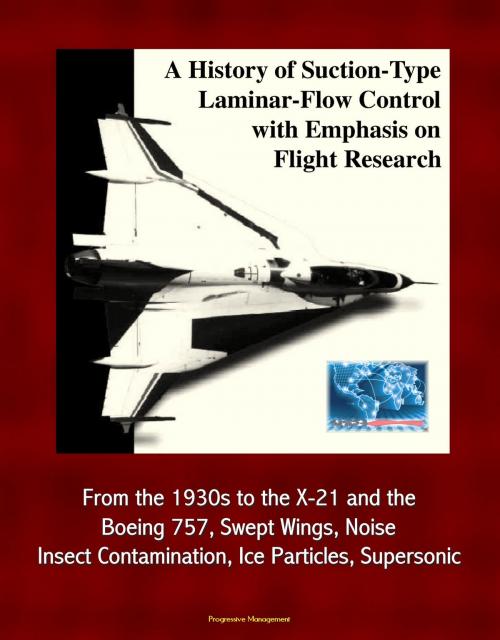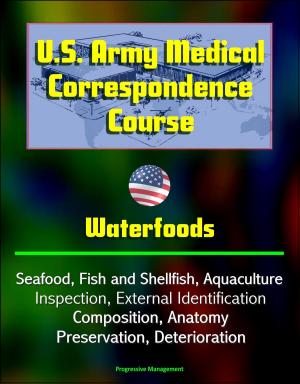A History of Suction-Type Laminar-Flow Control with Emphasis on Flight Research: From the 1930s to the X-21 and the Boeing 757, Swept Wings, Noise, Insect Contamination, Ice Particles, Supersonic
Nonfiction, Reference & Language, Transportation, Aviation, History, Science & Nature, Technology, Aeronautics & Astronautics| Author: | Progressive Management | ISBN: | 9781311801609 |
| Publisher: | Progressive Management | Publication: | May 13, 2015 |
| Imprint: | Smashwords Edition | Language: | English |
| Author: | Progressive Management |
| ISBN: | 9781311801609 |
| Publisher: | Progressive Management |
| Publication: | May 13, 2015 |
| Imprint: | Smashwords Edition |
| Language: | English |
Professionally converted for accurate flowing-text e-book format reproduction, this NASA report presents a history of that portion of laminar-flow technology known as active laminar-flow control, which employs suction of a small quantity of air through airplane surfaces. This important technique offers the potential for significant reduction in drag and, thereby, for large increases in range or reductions in fuel usage for aircraft. For transport aircraft, the reductions in fuel consumed as a result of laminar-flow control may equal 30 percent of present consumption. Laminar-flow control is an area of aeronautical research that has a long history at NASA's Langley Research Center, Dryden Flight Research Center, their predecessor organizations, and elsewhere. In this monograph, Albert L. Braslow, who spent much of his career at Langley working with this research, covers the early history of the subject and brings the story all the way to the mid-1990s with an emphasis on flight research, much of which has occurred here at Dryden. This is an important monograph that not only encapsulates a lot of history in a brief compass but also does so in language that is accessible to non-technical readers. NASA is publishing it in a format that will enable it to reach the wide audience the subject deserves.
Laminar-flow control is a technology that offers the potential for improvements in aircraft fuel usage, range or endurance that far exceed any known single aeronautical technology. For transport-type airplanes, e.g., the fuel burned might be decreased a phenomenal 30 percent. Fuel reduction will not only help conserve the earth's limited supply of petroleum but will also reduce engine emissions and, therefore, air pollution. In addition, lower fuel usage will reduce the operating costs of commercial airplanes at least eight percent, depending upon the cost of the fuel and, therefore, will curtail ticket prices for air travel. Laminar-flow control is also the only aeronautical technology that offers the capability of designing a transport airplane that can fly nonstop without refueling from anywhere in the world to anywhere else in the world or that can remain aloft without refueling for approximately 24 hours. These enormous performance improvements that are potentially available for commercial or military applications, therefore, have made the concept the "pot of gold at the end of the rainbow" for aeronautical researchers.
A brief review of some of the fundamentals involved will improve an understanding of this technological history. When a solid surface moves through a fluid (such as the air), frictional forces drag along a thin layer of the fluid adjacent to the surface due to the viscosity (stickiness) of the fluid. A distinguished theoretician, Ludwig Prandtl, showed in 1904 how the flow around a solid body can be divided into two regions for analysis—this thin layer of fluid adjacent to the surface, called the boundary layer, where fluid friction plays an essential part, and the remaining region outside the boundary layer where friction may be neglected. The boundary layer generally exists in one of two states: laminar, where fluid elements remain in well-ordered nonintersecting layers (laminae), and turbulent, where fluid elements totally mix. The frictional force between the fluid and the surface, known as viscous drag, is much larger in a turbulent boundary layer than in a laminar one because of momentum losses associated with the mixing action. The energy required to overcome this frictional force on an airplane is a substantial part of the total energy required to move the airplane through the air. In the case of a transport airplane flying at subsonic speeds, for example, approximately one-half of the energy (fuel) required to maintain level flight in cruise results from the necessity to overcome the skin friction of the boundary layer, which is mostly turbulent on current transport-size airplanes.
Professionally converted for accurate flowing-text e-book format reproduction, this NASA report presents a history of that portion of laminar-flow technology known as active laminar-flow control, which employs suction of a small quantity of air through airplane surfaces. This important technique offers the potential for significant reduction in drag and, thereby, for large increases in range or reductions in fuel usage for aircraft. For transport aircraft, the reductions in fuel consumed as a result of laminar-flow control may equal 30 percent of present consumption. Laminar-flow control is an area of aeronautical research that has a long history at NASA's Langley Research Center, Dryden Flight Research Center, their predecessor organizations, and elsewhere. In this monograph, Albert L. Braslow, who spent much of his career at Langley working with this research, covers the early history of the subject and brings the story all the way to the mid-1990s with an emphasis on flight research, much of which has occurred here at Dryden. This is an important monograph that not only encapsulates a lot of history in a brief compass but also does so in language that is accessible to non-technical readers. NASA is publishing it in a format that will enable it to reach the wide audience the subject deserves.
Laminar-flow control is a technology that offers the potential for improvements in aircraft fuel usage, range or endurance that far exceed any known single aeronautical technology. For transport-type airplanes, e.g., the fuel burned might be decreased a phenomenal 30 percent. Fuel reduction will not only help conserve the earth's limited supply of petroleum but will also reduce engine emissions and, therefore, air pollution. In addition, lower fuel usage will reduce the operating costs of commercial airplanes at least eight percent, depending upon the cost of the fuel and, therefore, will curtail ticket prices for air travel. Laminar-flow control is also the only aeronautical technology that offers the capability of designing a transport airplane that can fly nonstop without refueling from anywhere in the world to anywhere else in the world or that can remain aloft without refueling for approximately 24 hours. These enormous performance improvements that are potentially available for commercial or military applications, therefore, have made the concept the "pot of gold at the end of the rainbow" for aeronautical researchers.
A brief review of some of the fundamentals involved will improve an understanding of this technological history. When a solid surface moves through a fluid (such as the air), frictional forces drag along a thin layer of the fluid adjacent to the surface due to the viscosity (stickiness) of the fluid. A distinguished theoretician, Ludwig Prandtl, showed in 1904 how the flow around a solid body can be divided into two regions for analysis—this thin layer of fluid adjacent to the surface, called the boundary layer, where fluid friction plays an essential part, and the remaining region outside the boundary layer where friction may be neglected. The boundary layer generally exists in one of two states: laminar, where fluid elements remain in well-ordered nonintersecting layers (laminae), and turbulent, where fluid elements totally mix. The frictional force between the fluid and the surface, known as viscous drag, is much larger in a turbulent boundary layer than in a laminar one because of momentum losses associated with the mixing action. The energy required to overcome this frictional force on an airplane is a substantial part of the total energy required to move the airplane through the air. In the case of a transport airplane flying at subsonic speeds, for example, approximately one-half of the energy (fuel) required to maintain level flight in cruise results from the necessity to overcome the skin friction of the boundary layer, which is mostly turbulent on current transport-size airplanes.















